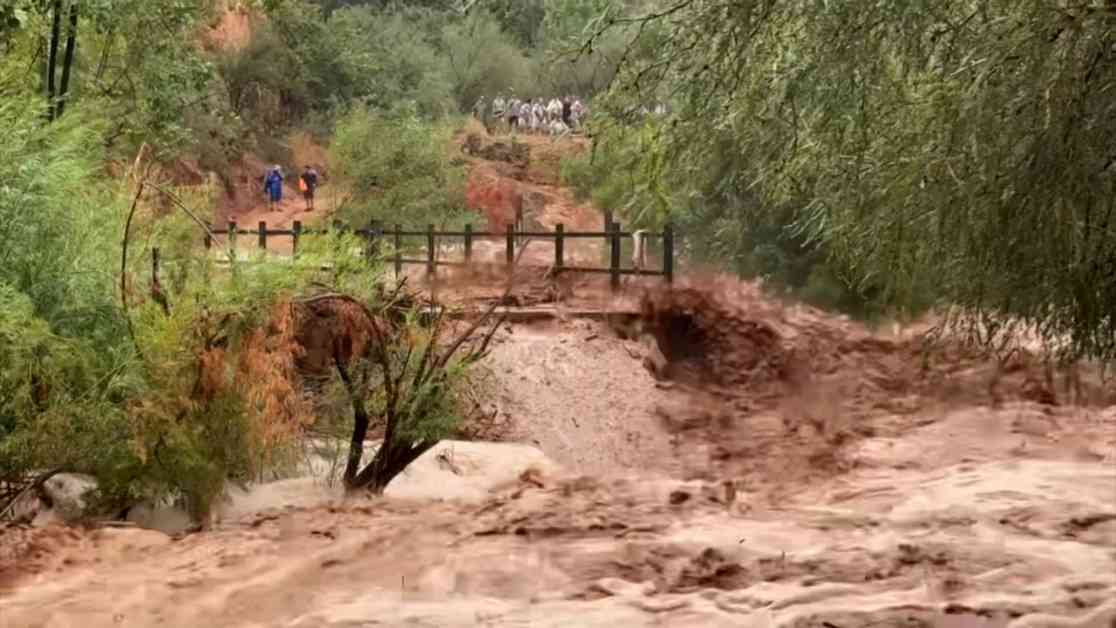Following a series of flash floods in Grand Canyon National Park that led to over a hundred rescues, the body of a missing hiker has been discovered along the Colorado River. The National Park Service confirmed that search and rescue operations commenced on Thursday after 33-year-old hiker Chenoa Nickerson was swept into Havasu Creek by the flash floods. Tragically, her body was found on Sunday near mile 176 of the Colorado River by a commercial river trip company.
The park service released a statement on Sunday, indicating that they are working with the medical examiner for Coconino County to investigate the circumstances surrounding Nickerson’s death. The news of her discovery comes amidst a challenging period for the Havasupai Tribe, whose grounds were inundated by dangerous floods that necessitated the evacuation of 104 visitors and tribal members. The Arizona National Guard deployed a UH-60 Blackhawk helicopter to assist with the evacuations, as monsoon storm-related flooding on Thursday prompted emergency responses and a closure of the area to tourists by local authorities.
In response to the flash floods, ground searchers navigated through Havasu Creek in Grand Canyon National Park, while the Havasupai Tribal Council announced the closure of the isolated community of Supai, located eight miles below the canyon’s rim. Arizona Governor Katie Hobbs mobilized the Arizona National Guard to aid in rescue operations on the Havasupai Indian Reservation, encircled by the national park. Despite the challenging conditions, CNN meteorologists forecasted a respite from rain in the area in the coming days.
As the events unfolded in Havasupai Indian Reservation on Thursday, a married couple from North Carolina recounted their harrowing experience to CNN. Shruti Chopra, 34, expressed shock at the severity of the flash flooding, noting that they were caught off guard by the rapidly rising waters. A Native American man on a mule alerted them to seek higher ground, prompting them to climb to safety as the floodwaters surged below. With six individuals in tow, including a family of four, they trekked through challenging terrain, forming human chains and navigating treacherous obstacles for hours.
Chopra vividly recalled the adrenaline-fueled moments of their escape, including narrowly avoiding a falling boulder that struck a tree in their path. Despite the danger, the group persevered, eventually reaching a settlement where they found refuge among fellow trekkers. Chopra and her spouse were eventually evacuated by the National Guard, finding shelter in a cove to shield themselves from the relentless rain. The resilience and cooperation displayed by the group during the crisis underscored the importance of preparedness and quick thinking in the face of natural disasters.
Impact of Flash Floods on Grand Canyon National Park
The recent flash floods in Grand Canyon National Park have underscored the unpredictable and potentially deadly nature of extreme weather events in the region. With monsoon storms exacerbating flooding risks, park officials have been vigilant in monitoring conditions and responding swiftly to protect visitors and residents. The tragic loss of hiker Chenoa Nickerson serves as a sobering reminder of the dangers posed by sudden flash floods in canyon areas, where water levels can rise rapidly and inundate low-lying areas with devastating consequences.
The Havasupai Tribe, whose ancestral lands lie within the canyon, has been particularly impacted by the recent floods, forcing the closure of the community of Supai to safeguard residents and visitors. The coordinated efforts of local authorities, the National Park Service, and the Arizona National Guard have been crucial in executing evacuations and ensuring the safety of those at risk. As the region grapples with the aftermath of the floods, the focus remains on recovery and mitigation strategies to prevent future tragedies.
Lessons Learned and Preparedness Measures
In the wake of the flash floods that swept through Grand Canyon National Park, there is a renewed emphasis on the importance of preparedness and awareness for hikers and visitors exploring the area. The swift and dynamic nature of flash floods requires individuals to stay informed about weather conditions, heed warnings from authorities, and have a plan in place for emergencies. Training in basic survival skills, such as identifying safe evacuation routes and seeking higher ground in flood-prone areas, can make a significant difference in navigating hazardous situations.
As witnessed in the accounts of survivors like Shruti Chopra and her companions, quick thinking and cooperation are essential during crises to ensure the safety and well-being of all involved. The willingness to assist others, form alliances, and adapt to changing circumstances can mean the difference between life and death in emergency situations. By sharing their experiences and insights, survivors of natural disasters can help educate others on the importance of preparedness, resilience, and community support in times of crisis.
Community Resilience and Recovery Efforts
In the aftermath of the flash floods in Grand Canyon National Park, the spirit of community resilience and solidarity has shone through as residents, visitors, and emergency responders come together to support one another. The evacuation efforts led by the Arizona National Guard and local authorities have demonstrated the dedication and resourcefulness of those tasked with ensuring the safety of all individuals in harm’s way. The outpouring of support from neighboring communities, tribal members, and volunteers has been instrumental in providing assistance and comfort to those affected by the floods.
As the region begins the process of recovery and rebuilding, a sense of unity and determination pervades the efforts to restore normalcy and address the challenges posed by the natural disaster. The lessons learned from the recent floods will inform future preparedness strategies and emergency response protocols to better safeguard individuals in vulnerable areas. By fostering a culture of resilience, cooperation, and proactive planning, communities can strengthen their ability to withstand and recover from the impact of natural disasters, ensuring the safety and well-being of all residents and visitors.


